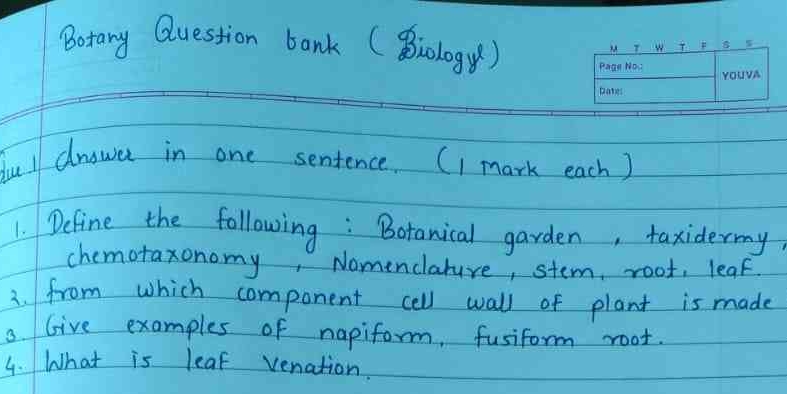1. Define the following: Botanical garden, taxonomy, nomenclature, stem, root, leaf. 2. From which component is the cell wall of the plant made? 3. Give examples of napiform and fu... 1. Define the following: Botanical garden, taxonomy, nomenclature, stem, root, leaf. 2. From which component is the cell wall of the plant made? 3. Give examples of napiform and fusiform roots. 4. What is leaf venation?

Understand the Problem
The question is asking for definitions and examples related to botany, specifically terms such as botanical garden, taxonomy, and components of plant structure. It also inquires about leaf venation. This suggests a focus on basic botany concepts.
Answer
1. Botanical garden: Plants for display. Taxonomy: Organism classification. Nomenclature: Naming system. Stem: Supports leaves. Root: Anchors plant. Leaf: Photosynthesis. 2. Cellulose. 3. Turnip, carrot. 4. Vein arrangement in a leaf.
- Botanical garden: A place where plants are grown for display and research. Taxonomy: The science of classification of organisms. Nomenclature: The system of naming organisms. Stem: The organ that supports leaves and flowers. Root: The organ that anchors the plant and absorbs water. Leaf: The organ responsible for photosynthesis.
- The plant cell wall is made of cellulose.
- Napiform example: Turnip. Fusiform example: Carrot.
- Leaf venation is the arrangement of veins in a leaf.
Answer for screen readers
- Botanical garden: A place where plants are grown for display and research. Taxonomy: The science of classification of organisms. Nomenclature: The system of naming organisms. Stem: The organ that supports leaves and flowers. Root: The organ that anchors the plant and absorbs water. Leaf: The organ responsible for photosynthesis.
- The plant cell wall is made of cellulose.
- Napiform example: Turnip. Fusiform example: Carrot.
- Leaf venation is the arrangement of veins in a leaf.
More Information
Plant taxonomy helps organize biological diversity. Botanical gardens conserve plant species and educate the public.
Tips
Common mistakes include confusing taxonomy and nomenclature, or using generic root examples like radish instead of turnip for napiform roots.
Sources
- Plant Structures | Biology for Majors II - courses.lumenlearning.com
- Botany | NC State Extension Publications - content.ces.ncsu.edu
- Introduction to Botany - students.aiu.edu
AI-generated content may contain errors. Please verify critical information